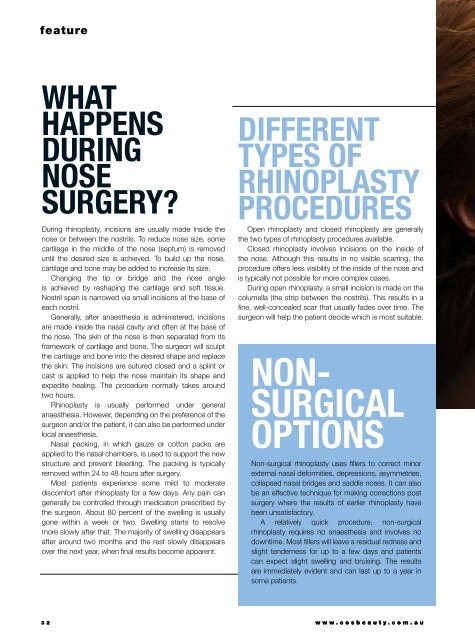Cosmetic Surgery & Beauty #72
Cosmetic Surgery and Beauty is the definitive consumer guide to aesthetic enhancement in Australia. Written by medical journalists and industry experts CSBM covers everything you need to know and with hundreds of untouched before and after photos it is the authoritative information source.
Cosmetic Surgery and Beauty is the definitive consumer guide to aesthetic enhancement in Australia. Written by medical journalists and industry experts CSBM covers everything you need to know and with hundreds of untouched before and after photos it is the authoritative information source.
Create successful ePaper yourself
Turn your PDF publications into a flip-book with our unique Google optimized e-Paper software.
feature<br />
What<br />
happens<br />
during<br />
nose<br />
surgery?<br />
During rhinoplasty, incisions are usually made inside the<br />
nose or between the nostrils. To reduce nose size, some<br />
cartilage in the middle of the nose (septum) is removed<br />
until the desired size is achieved. To build up the nose,<br />
cartilage and bone may be added to increase its size.<br />
Changing the tip or bridge and the nose angle<br />
is achieved by reshaping the cartilage and soft tissue.<br />
Nostril span is narrowed via small incisions at the base of<br />
each nostril.<br />
Generally, after anaesthesia is administered, incisions<br />
are made inside the nasal cavity and often at the base of<br />
the nose. The skin of the nose is then separated from its<br />
framework of cartilage and bone. The surgeon will sculpt<br />
the cartilage and bone into the desired shape and replace<br />
the skin. The incisions are sutured closed and a splint or<br />
cast is applied to help the nose maintain its shape and<br />
expedite healing. The procedure normally takes around<br />
two hours.<br />
Rhinoplasty is usually performed under general<br />
anaesthesia. However, depending on the preference of the<br />
surgeon and/or the patient, it can also be performed under<br />
local anaesthesia.<br />
Nasal packing, in which gauze or cotton packs are<br />
applied to the nasal chambers, is used to support the new<br />
structure and prevent bleeding. The packing is typically<br />
removed within 24 to 48 hours after surgery.<br />
Most patients experience some mild to moderate<br />
discomfort after rhinoplasty for a few days. Any pain can<br />
generally be controlled through medication prescribed by<br />
the surgeon. About 80 percent of the swelling is usually<br />
gone within a week or two. Swelling starts to resolve<br />
more slowly after that. The majority of swelling disappears<br />
after around two months and the rest slowly disappears<br />
over the next year, when final results become apparent.<br />
Different<br />
types of<br />
rhinoplasty<br />
procedures<br />
Open rhinoplasty and closed rhinoplasty are generally<br />
the two types of rhinoplasty procedures available.<br />
Closed rhinoplasty involves incisions on the inside of<br />
the nose. Although this results in no visible scarring, the<br />
procedure offers less visibility of the inside of the nose and<br />
is typically not possible for more complex cases.<br />
During open rhinoplasty, a small incision is made on the<br />
columella (the strip between the nostrils). This results in a<br />
fine, well-concealed scar that usually fades over time. The<br />
surgeon will help the patient decide which is most suitable.<br />
Nonsurgical<br />
options<br />
Non-surgical rhinoplasty uses fillers to correct minor<br />
external nasal deformities, depressions, asymmetries,<br />
collapsed nasal bridges and saddle noses. It can also<br />
be an effective technique for making corrections post<br />
surgery where the results of earlier rhinoplasty have<br />
been unsatisfactory.<br />
A relatively quick procedure, non-surgical<br />
rhinoplasty requires no anaesthesia and involves no<br />
downtime. Most fillers will leave a residual redness and<br />
slight tenderness for up to a few days and patients<br />
can expect slight swelling and bruising. The results<br />
are immediately evident and can last up to a year in<br />
some patients.<br />
32 www.cosbeauty.com.au

















